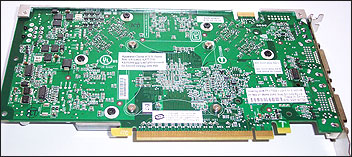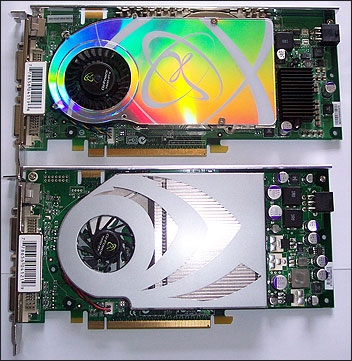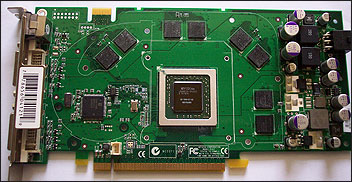Board Examination
When new graphics technology is first launched HEXUS usually looks at reference boards, but NVIDIA's allocation for the UK looked set to arrive far too late in the day from the US to be useful in having an article ready for today. So we got in touch with XFX who gladly gave up one of its samples, which uses the reference board and cooler design, in enough time for it to be useful to us. Cheers Keith!The XFX board customisation can be seen quite clearly. XFX attaches a metal bar to the top edge of the board and its sticker adorns the fan. Otherwise it's reference stuff through and through. Compared to the GTX, the GT makes less use of digital VRM circuitry for power management. It's less expensive to use traditional FETs and capacitors and cost is one of the GT's drivers.
The rear of the board shows how the heatsink is mounted. While the GTX used retention brackets, the GT uses none with the single piece heatsink assembly simply screwed to the board from the rear instead.
The XFX GT weighs nearly 100 grams more than the reference 7800 GTX. At 416g, it's a bit of a porker compared to the svelte 320g of a reference GTX. Theres a much larger main heatsink pressed against the G70 on the GT, which accounts for the majority of the extra mass.
Compared to a GTX, the PCB is a touch smaller in width and identical in height. The fan on the single-slot cooler is an ADDA AD4512HB-E01. The 12V DC fan draws less than 4W at full speed. Flat out the volume of air it moves makes, subjectively to my tired old ears, a touch more noise than a full-pelt GTX reference board. The cooler design is the culprit for that. Thankfully it's temperature controlled and rarely hits its maximum speed.
Naked, you can see the large die, A2 silicon and produced in early June, surrounded by eight DRAM devices. The XFX board, like the reference hardware NVIDIA is sampling to press, uses Infineon's HYB18T256324F-20 DRAMs. They're 500MHz BGA devices rated at 2.0V, rather than the 1.8V that the Samsung ICs usually used are driven at.
The Philips chip is for the VIVO functionality, rather than being a dual-link DVI TMDS connected to one of the GPU's DVO ports, as we claimed in the 7800 GTX article! The GPU drives one single-link and one dual-link (port nearest the S-Video connector) DVI port using internal transmitters.
NVIDIA claim the GT is an 85W part in reference configuration, in terms of output power it'll pull from the PSU, compared to a GTX's 100 watts. Given the clocks and active functional units, the deficit seems correct. Consequently NVIDIA recommend at least a 350W PSU with 22A current ability from +12V. 85W means a rough 7A max from the graphics board. For this article HEXUS used a Tagan 420W X-Eye PSU for all of the testing, with no stability problems.













